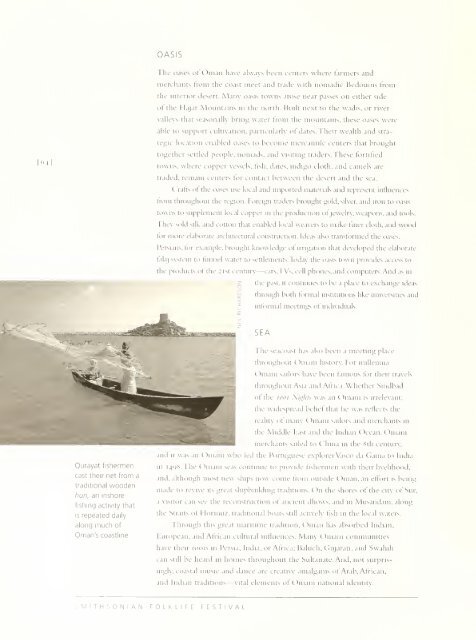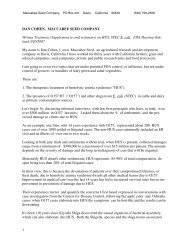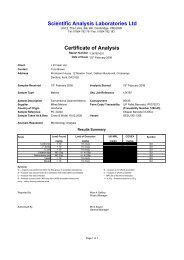OASISIhe oases of Oman have always been centers where farmers andmerchants from the coast meet and trade with nomadic Bedouins fromthe interior desert. Many oasis towns arose near passes on either sideof the Hajar Mountains inthe north. Built next to the wadis, or rivervalleys that seasonally bring water from the mountains, these oases wereable to support cultivation, particularly of dates. Their wealth and strategiclocation enabled oases to become mercantile centers that brought64]together settled people, nomads, and visiting traders. These fortifiedtowns, where copper vessels, fish, dates, indigo cloth, and camels aretraded, remain centers for contact between the desert and the sea.t 'rafts ot the oases use local and imported materials and represent influencesfrom throughout the region. Foreign traders brought gold, silver, and iron to oasistowns to supplement local copper 111 the production ot jewelry, weapons, and tools.I he\ sold silk and cotton that enabled local weavers to make finer cloth, and woodtor more elaborate architectural construction. Ideas also transformed the oases.Persians, tor example, brought knowledge ot irrigation that developed the elaboratefalajsystem to tunnel water to settlements. Today the oasis town provides access tothe products ot the 21st century—cars, TVs, cell phones, and computers. And as 111the past, itcontinues to be a place to exchange ideasthrough both formal institutions like universities andinformal meetings ot individuals.SEAThe seacoast has also been ameeting placethroughout Omani history. For millenniaOmani sailors have been famous tor their travelsthroughout Asia and Africa. Whether Sindbadot the tool Xifilih was .\n Omani is irrelevant;the widespread belief that he was reflects thereality ot many Omani sailors and merchants mthe Middle East and the Indian Ocean. Omanimerchants sailed to China inthe Nth century,and itwas an Omani who led the Portuguese explorer Vasco da (¡ama to IndiaQurayat fishermenin1498. The Omani seas continue to provide fishermen with their livelihood,cast their net from atraditional woodenhurí,an inshorefishing activity thatisrepeated dailyalong much ofOman's coastline.and. although most new ships now come from outside Oman, an effort is beingmade to revive its great shipbuilding traditions. On the shores of the city of Stir,a visitor caw see the reconstruction ot ancient dhows, and in Musandam, alongthe Straits oí I lormuz, traditional boats still actively fish 111 the local waters.Through this great maritime tradition, Oman has absorbed Indian,European, and African cultural influences. Many Omani communitieshave their roots inPersia, India, or Africa; Baluch, Gujarati, and Swahilican still be heard 111 homes throughout the Sultanate. And, not surprisingly,coastal music and dance are creative amalgams ot Arab, African,and Indian traditions—vitalelements ot Omani national identity.SMITHSONIAN FOLKLIFE FESTIVAL
THE FESTIVAL PROGRAMThe 200s <strong>Smithsonian</strong> Folklife Festival programon Oman features over ioo musicians, dancers,craftspeople, and cooks representing culturaltraditions trom the desert, oasis, and sea. Thedate-leaf baskets and decorative wool carpetsmade tor easy transport by nomadic desertpeoples provide a striking contrast to theheavy copper vessels and elaborate silverworkproduced by craftsmen in the oases, while proudshipbuilders demonstrate skills that have madeOmani ships renowned throughout the IndianOcean. The fabled frankincense that in someways represented to the ancient Mediterraneanworld what oil does to modern economies isstillgrown in the south and used throughout Oman.A section ot the program features a variety ofOmam adornments including aromatics suchas frankincense, as well as textiles and jewelry.Most Omam music accompanies dance andis present at celebrations ot all kinds around thecountry. People rejoice with music and danceat births and weddings, use them sometimesfor healing, and celebrate with them at timesof victory. Men's and women's dance is accompaniedby musical instruments that display thecultural influences ot the region—stringedinstruments trom India, wind instruments tromPersia, drums trom Africa, and even bagpipes(originally from Egypt but more recently playedby British military troops in residence in Oman)are allpart ot the sounds of Omam music.The 2005 program is the first to feature anArab nation at the <strong>Smithsonian</strong> Folklife Festival.Arabs and Arab Americans have participatedin past Festivals, but this program provides anopportunity to tocus on an Arab culture at atime when the Arab world isunfortunatelymuch misunderstood here. We hope the Omanprogram will dispel some myths about theregion and even include a tew pleasant surprisestor those knowledgeable ot the region.[65]NOTE ON TRANSLITERATIONArabic words that have been incorporated into English,including place names found in Webster's Dictionary, areprimarily written in their English form. Transliterationsof other words from the Arabic to the Roman alphabetare usually guided by Library ot Congress usage. Inmost cases, transliterations are made from ModernStandard Arabic words, not from words in Omamdialect(s). Diacritical marks are omitted unless they arean integral part ot the language. Readers will notice thefollowing two marks:(')An apostrophe to indicate the break in soundthat occurs in the middle of some Arabic words(') A single, inward-facing quote to represent the'ayn consonant which does not occur in EnglishSUGGESTED READINGAgius, Dionisius. 2003. Seafaring in the ArabianGulf and Oman.The People of the Dhow.London: Kegan Paul International.Callan, Lou, and Gordon Robison. 2000. Oman &the I 'titled Arab Emirates. Melbourne: Lonely Planet.The Journal ot Oman Studies, 1 bis. 1-12.197S-2002. Muscat: Ministry of Heritageand Culture. Sultanate of Oman.Ministry of Information, Sultanate ofOman: http://www.omanet.omOwtram, Francis. 2004. A Modern History of Oman:Formation of the State since 1920. London: I.B.Tauris.Stevens, Andre, 1990. Oman: Citadels between Sandand Sea. Winksele. Belgium: Terra Incognita.Wikan, Unni. 1991. Behind the I HI in Arabia: WomeninOman. Chicago: University of Chicago Press.RICHARD KENNEDY isthe curator ofthe 2005 Festival program on Oman andDeputy Director ot the <strong>Smithsonian</strong> Centerfor Folklife and Cultural Heritage. He has cocuratedFestival programs on the Silk Road.Tibetan culture, the Philippines, Russian music,Thailand, Indonesia, and Hawai'i. His Ph.D.isin South and Southeast Asian Studies fromthe University ot California at Berkeley.Hawley, Donald. 1984. Oman & ItsRenaissance.Second edition. London: Stacey International.All photographs courtesy oj the Omani Craft HeritageDocumentation Project unless noted otherwise.OMAN: DESERT, OASIS, AND SEA
- Page 1:
Smithsonianolklife Festival\Food Cu
- Page 4 and 5:
The annual Smithsonian Folklite Fes
- Page 7 and 8:
—CONTENTSThe Festival's Timely Ap
- Page 9 and 10:
—THE FESTIVAL'S TIMELY APPEALLAWR
- Page 11 and 12:
COMMERCE FOR CULTUREFrom the Festiv
- Page 13 and 14:
[ii]The food concession for the Mel
- Page 15 and 16: oMiiitbioni.indotal SoundL04.A 1 Sl
- Page 17: 1WELCOME TO THE 2005 FOLKLIFE FESTI
- Page 20 and 21: Workers harvest artichokes at Ocean
- Page 22 and 23: —assigned aparticular dish—meat
- Page 24 and 25: I--IPot Pie Farm manager Elizabeth
- Page 26 and 27: ISustainable farmers such as Eliot
- Page 28 and 29: "IThe numberof programsdesignedfor
- Page 30 and 31: .hadSALAD GREENS WITH GOAT CHEESE,
- Page 32 and 33: w.A>wm:~
- Page 34 and 35: —3 3]OCCUPATIONAL CULTUREThe 2005
- Page 36 and 37: employees, the USDA Forest Servicei
- Page 38 and 39: I[3 6]page book, which could fit in
- Page 40 and 41: ká.!i- .>!mKPA backpacker sets up
- Page 42 and 43: --^i'liunterw eight jihI ...itl jib
- Page 44 and 45: —4-"The essentialpiece isto captu
- Page 46 and 47: I44cutDUTCH OVENONE-POT MEALThomas
- Page 48 and 49: —FUTURE CONCERNS FOR PUBLIC LANDS
- Page 50 and 51: NUESTRA MÚSICA: MUSIC INBuilding C
- Page 52 and 53: plena groups throughout the Northea
- Page 54 and 55: NUESTRA MÚSICA LAUNCHES NEW SERIES
- Page 56 and 57: NUESTRA MÚSICA: MUSIC IN LATINO CU
- Page 58 and 59: "ILos Camperos de Valles son músic
- Page 60 and 61: RAICES LATINASNUESTRA MÚSICA LANZA
- Page 63 and 64: IOMAN: DESERT, OASIS, AND SEARICHAR
- Page 65: DESERTThe deserts ot the Arabian Pe
- Page 70 and 71: 6 8The coiled, leather-covered bask
- Page 72 and 73: 70]COASTAL CRAFTSMANSHIPAND GLOBAL
- Page 74 and 75: [72]Although the oldismaking way fo
- Page 76 and 77: AN OMANI FOLKTALEASYAH AL-BUALYOman
- Page 79 and 80: y%aMUSIC AND DANCE INOMANOMAN CENTR
- Page 81: In the southern Dhufar region, al-b
- Page 84 and 85: ecosystems, identification of plant
- Page 86 and 87: 2:00IIIVorkshopFESTIVAL SCHEDULE (P
- Page 88 and 89: Rhythm,Saturday, June 25 (Programs
- Page 90 and 91: )avidi nestMonday, June 27(Programs
- Page 92 and 93: 1:00IIlamFriday, July 1 (Programs a
- Page 94 and 95: )utchSunday, July 3(Programs are su
- Page 96 and 97: EVENING CONCERTSSounds of the Fores
- Page 98 and 99: theRELATED EVENTS[96]Nuestra Músic
- Page 100 and 101: IIDónalas Anderson,Washington, D.C
- Page 102 and 103: 'IEd LiíDmi, Studio City, Californ
- Page 104 and 105: ISudhir Seth, Bethesda, MarylandA g
- Page 106 and 107: 1 if 1 DumberHoneyBeehive Beeproduc
- Page 108 and 109: 1"''NewI >onI Lui\IDon Bustos,Espa
- Page 110 and 111: Ian Barlow, White Bird,Idaho; Woodl
- Page 112 and 113: I 'istnet1Gordon Grant,Corvallis, O
- Page 114 and 115: Kristen Marline, Flagstaff,Arizona;
- Page 116 and 117:
I1 ountries,IIHistorie Site, once t
- Page 118 and 119:
1IworksI1 11Istations are vital to
- Page 120 and 121:
1'IenIpanderetas;JCJ Band. Washingt
- Page 122 and 123:
Ralph Rinzlersongs are "made" (or c
- Page 124 and 125:
I >cmseI VhorahII MiI lameEne Nance
- Page 126 and 127:
|i 2forIIBartlevy1 )oerr;IIParadeSP
- Page 128 and 129:
II AerialIIII1Washington and Jeffer
- Page 130 and 131:
Stack, Bill Stafford, loni Stafford
- Page 132 and 133:
SMITHSONIAN FOLKLIFE FESTIVAL 20051
- Page 135 and 136:
SMITHSONIAN FOLKLIFE FESTIVAL 2005B
- Page 138:
Smithsonian Folklife FestivalSMITHS








